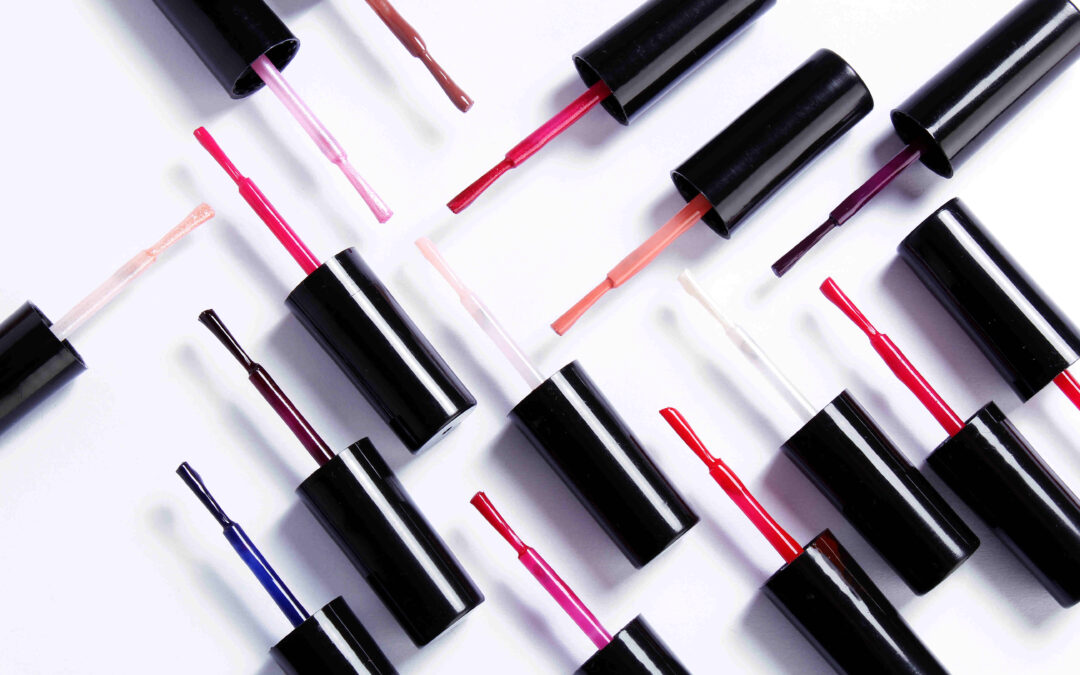Although many cosmetic products have been known to mankind since ancient times, the nail polish manufacturing process is relatively recent and dates back to the early 20th century.
Table of contents:
Nail polish manufacturing process. What are nail polishes?
Before explaining how nail polish is made, it is important to explain what this popular cosmetic product is. Nail polishes and nail care enamels are solutions of so-called film-forming substances such as cellulose esters with resins and plasticisers in organic solvents. Various colourants, pigments and glitters are added to these substances to give the polish an attractive appearance, although transparent polishes are also available.
When applied, nail polishes and enamels form a special decorative and protective layer on the nail. Unlike most cosmetic products, the composition of nail polish is relatively simple. However, it is important to remember that the polish must also contain ingredients that make it long-lasting and easy to apply. This is because nail polish, unlike other cosmetics, stays on the nail surface for a long time, making this product’s requirements quite specific.
Composition of nail polish
Anyone involved in the nail polish manufacturing process should know what makes good polish. Not only the decorative and protective function is important, but also the ease of application on the nails and the appropriate viscosity of the varnish. A properly formulated product should be thixotropic. What does it mean? Once applied to the nail, the polish will behave like a gel and will not run off the nail, but when force is applied during application with a brush, it will easily spread to form a thin layer on the nail plate.
For these reasons, nail polish manufacturing is always preceded by a careful process to create the right polish formula. Each is different and unique, of course, but there are a few ingredients that always go into every polish. The first is nitrocellulose, which creates a shiny layer with the proper hardness and adhesion. Sometimes polymers such as polyvinyl acetate, nitro starch or ethyl cellulose acetate are added.
Resins, such as damar, copal or rosin, are other ingredients in nail polishes and enamels. They improve the adhesion of the polish to the nail plate and its hardness. Besides the natural resins mentioned above, synthetic substances such as methacrylate or polyvinyl resins are often used.
Plasticisers add flexibility to the polish. They prevent the polish from wrinkling on the nail after the solvent has evaporated. These are solvent-based plasticisers, mainly high-molecular-weight esters, and non-solvent plasticisers, also known as softeners.
Approximately 80% of the weight of the polish is solvent. A mixture of low, medium and high boiling point solvents is commonly used. They are responsible for reducing the drying time of the polish and increasing its gloss. Solvents are often combined with thinners, which are mainly used to reduce the cost of the nail polish manufacturing process.
Of course, nail polish also contains various colourants soluble in the solvent used. Enamels use insoluble inorganic pigments and lakes. Surfactants are also added to prevent the colour substance from falling into the liquid layers below.
Packaging and perfume production
The nail polish manufacturing process is complex and requires specialist knowledge and state-of-the-art machinery. It is the combination of highly skilled personnel and the right production tools that bring easy-to-apply yet durable polish to the market.
The first stage in the manufacture of polish is the preparation of the paint binder. This process involves dissolving the nitrocellulose and resins in a unique mixture of volatile ingredients and achieving the right consistency of the prepared solution.
The next part of the production process is to grind the pigments and softeners into a single colour paste. Double or triple drum mills are most commonly used for this purpose. The pastes obtained from the grinding process are then tinted to the required colour. This is done in a mixer where the individual pigments are combined.
The pastes thus prepared, which are semi-finished products, are sent to the department where the enamel is prepared in boilers. For this purpose, the coloured pastes are placed in mixers into which the binder has previously been added. The mixer mixes the pastes and the binder until a homogeneous substance is obtained.
The final step is to pour the finished polish into individual containers. This is done using special dispensing machines, such as Unilogo’s Cosmoline 30 Nail Polish. This special machine not only dispenses precisely the right amount of product but also closes the filled container with a servo-driven capping machine.
Perfume production – summary
Creating the perfect nail polish is no easy task. Not only does it have to look good, but it also has to be durable and easy to apply. Good nail polish should be thixotropic, which means it should not run off the nail after application, but it should also be easy to apply with a brush.
The first step in making polish is to develop its composition. This is, of course, unique to each product, but virtually every polish contains ingredients such as nitrocellulose, plasticisers and, of course, colourants.
Once the formulation has been developed, the actual manufacturing process can begin. This multi-stage process involves combining the individual ingredients in carefully selected proportions. State-of-the-art machines such as drum mills, mixers and dispensers are used to produce the polishes.
If you are currently looking for a nail polish dispensing line or any other type of production equipment, you should take a look at our extensive range of machinery or use the contact form on our website. Unilogo’s team of specialists will answer all your questions and help you choose the perfect machine for your business.


